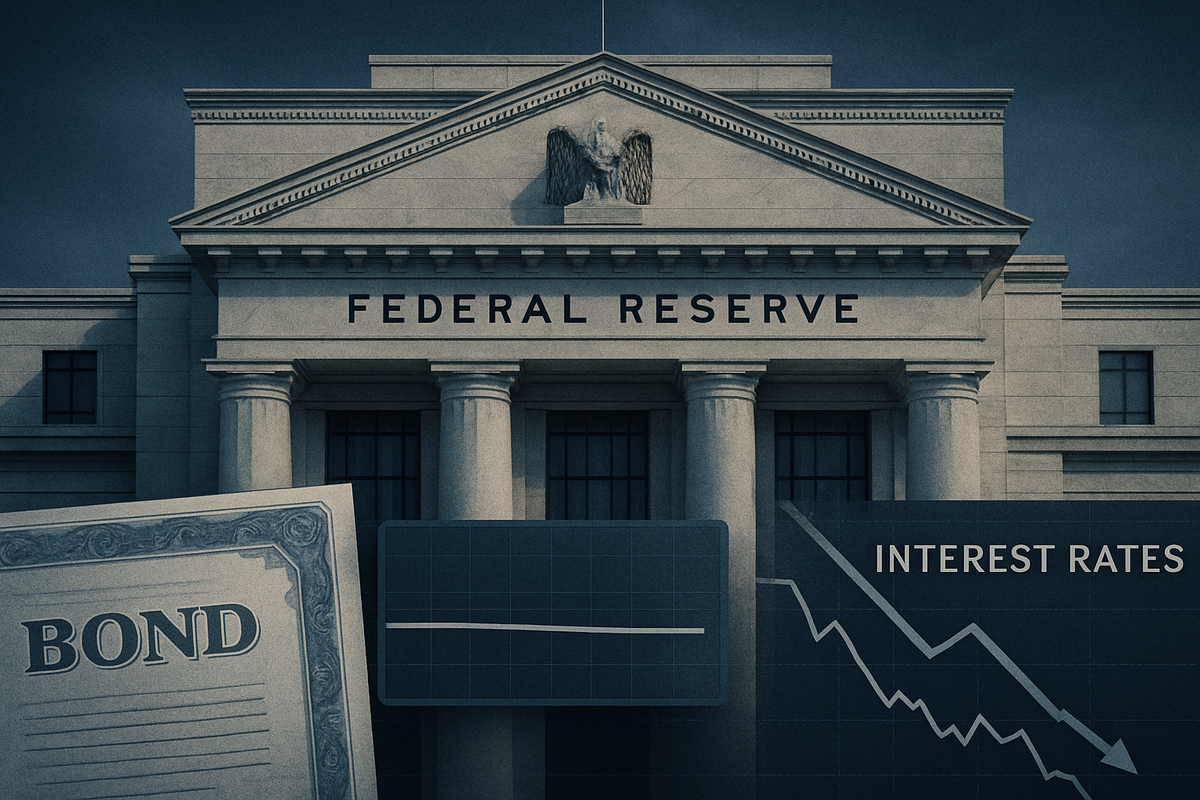
Washington D.C. – October 7, 2025 – Federal Reserve Governor Stephen Miran, a relatively new voice on the Federal Open Market Committee (FOMC), has today issued a forceful argument for aggressive interest rate reductions, asserting that the current tranquility in the bond market provides an opportune moment for the central bank to act decisively. His statements, made on October 7, 2025, highlight a growing divergence within the Fed regarding the appropriate pace and magnitude of monetary easing, potentially signaling a more dovish path than many of his colleagues currently envision.
Miran’s call for swift cuts comes amidst concerns that the Fed's current monetary policy remains "very restrictive," posing "material risks" to the nation's employment mandate. His perspective, which challenges the prevailing cautious approach, suggests that the market’s stability at the long end of the yield curve removes a significant impediment to lowering borrowing costs, thereby supporting economic growth and mitigating the threat of unnecessary job losses.
Miran's Dissent Sparks Debate on Monetary Policy Trajectory
Governor Miran, who joined the Federal Reserve Board on September 16, 2025, has wasted no time in making his stance known. Today's remarks build upon his dissenting vote at the September 2025 FOMC meeting, where he advocated for a more substantial 50-basis-point (0.50%) interest rate cut, rather than the 25-basis-point reduction that was ultimately approved. This September cut, the first since December 2024, brought the federal funds rate to a target range of 4.00%-4.25%. Miran, however, believes the appropriate federal funds rate should be considerably lower, closer to the mid-2% range.
His reasoning is rooted in a belief that the neutral interest rate – the rate that neither stimulates nor slows the economy – has significantly declined due to a confluence of "nonmonetary factors" in 2025. Miran specifically points to a dramatic shift in immigration policy, estimating a net decrease of approximately 1.5 million immigrants in the first half of the year. He argues this demographic change alone could reduce the neutral fed funds rate by nearly 0.4 percentage points annually. Furthermore, he cites recent changes in tax legislation and trade policies as factors contributing to increased national saving, thereby exerting further downward pressure on the neutral rate. According to Miran, failing to account for these shifts leads to an overestimation of how restrictive current policy truly is.
While the general market reaction to the September 2025 rate cut was largely anticipated and positive for borrowers and bondholders, Miran's more aggressive stance could, if adopted, necessitate a "radical adjustment" in market pricing. Analysts suggest that if yields were to fall to his estimated levels, the price of 10-year U.S. Treasury Inflation-Protected Securities (TIPS) could see a substantial rise of approximately 10%. Historically, aggressive rate cuts have also provided a significant boost to riskier assets, including cryptocurrencies like Bitcoin (BTC-USD), which saw a jump after the September rate cut. However, these are broader observations, and Miran's individual statements have not yet triggered distinct, immediate market movements, though they certainly contribute to the ongoing dialogue about the future direction of monetary policy.
Market Winners and Losers: A Shifting Landscape Under Easing Policy
The prospect of aggressive interest rate cuts, as championed by Governor Miran, would undoubtedly reshape the financial landscape, creating clear winners and losers across various sectors. The primary mechanisms at play involve reduced borrowing costs, increased liquidity, and altered company valuations, which would favor growth-oriented and capital-intensive industries while potentially challenging some traditional financial institutions.
Beneficiaries of Lower Rates: The Technology sector stands to be a significant winner. Growth-stage tech companies, particularly in areas like Software-as-a-Service (SaaS) and biotechnology, often rely heavily on borrowed capital for research, development, and scaling operations. Lower interest rates directly reduce their cost of capital, making it cheaper to fund innovation and expansion. Moreover, the valuation of these companies, often based on future growth potential, benefits immensely from lower discount rates, leading to higher stock prices. Similarly, the Real Estate and Home Construction sector would experience a substantial boost. Lower mortgage rates make homeownership more affordable, stimulating demand and potentially driving up property values. Homebuilders such as D.R. Horton (NYSE: DHI), Lennar (NYSE: LEN), PulteGroup (NYSE: PHM), and Toll Brothers (NYSE: TOL) would likely see increased sales and project starts. Real Estate Investment Trusts (REITs), especially those in data centers or telecommunications, would also benefit from reduced financing expenses and potentially higher property values.
The Consumer Discretionary sector would also thrive as lower borrowing costs and improved consumer confidence encourage spending on non-essential goods and services. This includes sectors like automotive (e.g., General Motors (NYSE: GM), Ford (NYSE: F)), luxury retail, and hospitality (e.g., Marriott International (NASDAQ: MAR), Hilton Worldwide (NYSE: HLT)). Small-Cap Stocks across the board are also poised for significant gains, as these smaller companies often carry higher debt loads and are more sensitive to interest rate fluctuations. Reduced debt servicing costs and improved liquidity would disproportionately enhance their growth prospects. Finally, the Utilities sector, being highly capital-intensive, would see reduced financing costs for infrastructure projects, making their stable dividend yields more attractive to investors.
Potential Challenges: Conversely, certain segments of the Financial sector, particularly traditional banks, might face challenges. While lower rates can stimulate overall lending activity, aggressive cuts can compress net interest margins (NIM) – the difference between what banks earn on loans and pay on deposits. Smaller regional banks, in particular, could struggle to maintain profitability in a very low-rate environment. Large, diversified banks like JPMorgan Chase (NYSE: JPM) or Bank of America (NYSE: BAC) might fare better due due to their capital markets activities, which often benefit from increased market liquidity and activity. Insurance companies, especially those with long-duration liabilities like life insurers, could also see their profitability impacted as returns on their fixed-income investment portfolios decline and the present value of their liabilities increases. While not universally negative, some specific sub-sectors of REITs, such as lodging or mall REITs, might see more muted reactions compared to other real estate segments, as their performance is often more tied to specific economic cycles and consumer behavior.
The overall impact hinges on the depth and speed of the rate cuts. While many sectors would welcome the stimulus, investors would need to carefully assess individual company balance sheets and business models to identify those best positioned to navigate the shifting monetary policy landscape.
Broader Implications: A Potential Shift in Global Economic Tides
Governor Miran's strong advocacy for aggressive interest rate cuts, if embraced by the broader Federal Open Market Committee, signals a profound shift in U.S. monetary policy with far-reaching implications that extend beyond domestic markets. This move would embed itself within broader industry trends of economic stimulation, potentially causing significant ripple effects on global competitors, partners, and regulatory frameworks.
Industry Trends and Global Dynamics: A sustained period of lower U.S. interest rates would generally aim to stimulate economic activity by making borrowing more affordable for businesses and consumers. This environment would particularly bolster capital-intensive sectors and growth-oriented companies. Beyond the direct impact on U.S. industries, aggressive rate cuts typically lead to a weaker U.S. dollar. A depreciated dollar makes U.S. exports more competitive on the international stage, potentially benefiting American multinational corporations and exporters by boosting overseas sales and repatriated earnings. Conversely, it could make imports more expensive, impacting companies reliant on foreign goods. For global partners, particularly emerging markets, lower U.S. rates can alleviate pressure on their currencies and reduce the cost of servicing dollar-denominated debt, potentially attracting capital inflows as investors seek higher yields outside the U.S. This, however, also introduces a degree of volatility as capital flows can be fickle.
Regulatory and Policy Considerations: A decisive pivot towards aggressive easing by the Fed would likely prompt other central banks around the world to reassess their own monetary policies. To maintain currency competitiveness and support their domestic economies, central banks in Europe, Asia, and other regions might consider their own easing measures, potentially triggering a coordinated or reactive global monetary policy shift. While such collective easing could provide a global economic cushion, it also raises concerns about escalating global debt levels. Furthermore, policymakers would face the delicate balancing act of stimulating growth without inadvertently re-igniting inflation or fostering asset bubbles. Historical precedents show that extended periods of exceptionally low interest rates can encourage excessive risk-taking, potentially leading to asset price inflation if not carefully managed by robust regulatory oversight. The Fed, in its dual role of setting monetary policy and safeguarding financial stability, must navigate these potential conflicts.
Historical Context and Precedents: History offers numerous examples of aggressive Fed rate-cutting cycles, often occurring during or in anticipation of economic downturns. For instance, the Fed's actions during the early 2000s after the dot-com bust and 9/11, and most notably during the 2007-2008 Global Financial Crisis, saw rapid and substantial rate reductions to stabilize the financial system and prevent a deeper collapse. In 2007-2008, the Fed slashed rates from 5.25% to near zero within 15 months. While rate cuts are typically intended to avert or mitigate recessions, historical data suggests they don't always succeed. Out of 10 previous rate-cutting cycles, only two avoided a subsequent recession, indicating the limitations of monetary policy once broader economic momentum deteriorates. However, periods like 1984, 1995, and 1998 did see rate cuts without a recession, often characterized as "mid-cycle adjustments." Governor Miran's current call for aggressive cuts in October 2025, if acted upon, would imply a heightened concern about the economy's trajectory, possibly due to a more pronounced weakening of the labor market or increased risks of disinflation, even if the economy showed robust growth earlier in the year.
The Road Ahead: Navigating a New Monetary Policy Landscape
The assertive stance taken by Fed Governor Stephen Miran on aggressive interest rate cuts introduces a compelling dynamic into the monetary policy debate, signaling a potential shift that could define the economic trajectory for the foreseeable future. The short-term and long-term implications for businesses, investors, and the broader economy are significant, presenting both opportunities and formidable challenges.
Short-Term Catalysts and Long-Term Risks: In the immediate term (3-12 months), aggressive rate cuts would translate to lower borrowing costs for both consumers and businesses. This is expected to stimulate consumer spending on big-ticket items, boost the housing market through reduced mortgage rates, and likely trigger an initial stock market rally, particularly benefiting interest-rate-sensitive sectors like technology and housing. Businesses would find cheaper capital for expansion and investment. However, this immediate relief comes with long-term complexities. A prolonged period of low rates risks re-igniting inflation, especially if underlying economic conditions are stronger than perceived or if supply-side pressures persist. It could also lead to asset bubbles in real estate and equities, and potentially compress net interest margins for financial institutions over time, impacting their profitability and resilience.
Strategic Adaptations and Emerging Market Dynamics: Businesses must strategically adapt to this evolving environment. Key pivots include aggressively refinancing existing debt to capitalize on lower borrowing costs, accelerating investments in growth initiatives and technological upgrades, and meticulously managing cash flow as returns on savings accounts diminish. Robust risk management, including hedging against currency fluctuations and commodity price volatility, becomes paramount. For investors, opportunities could emerge in equities, particularly growth stocks and defensive utilities, as well as in housing, construction, and potentially gold and other commodities that historically perform well during easing cycles. However, challenges include the risk of inflation eroding purchasing power, reduced returns for savers, and potential market volatility if economic uncertainty persists. The "sell-the-news" phenomenon could also lead to short-term dips even after anticipated cuts.
Potential Scenarios and Investor Vigilance: The future could unfold in several ways. The most favorable outcome is a "soft landing," where rate cuts successfully stimulate demand and bring the economy to sustainable growth without triggering inflation. Conversely, a "too much, too early" scenario could see the economy overheat, forcing the Fed to reverse course and potentially leading to a harder landing later. A more concerning scenario is "stagflation," where inflation remains stubbornly high despite weakening growth, a challenging environment for most. Investors should closely watch key economic indicators such as inflation data, labor market reports, and consumer spending trends. The Fed's communications, particularly any shifts in tone from other FOMC members, will be crucial in gauging the likelihood of Miran's aggressive stance gaining wider traction. Understanding the interplay between monetary policy, inflation expectations, and global economic conditions will be vital for navigating the months ahead.
This content is intended for informational purposes only and is not financial advice





